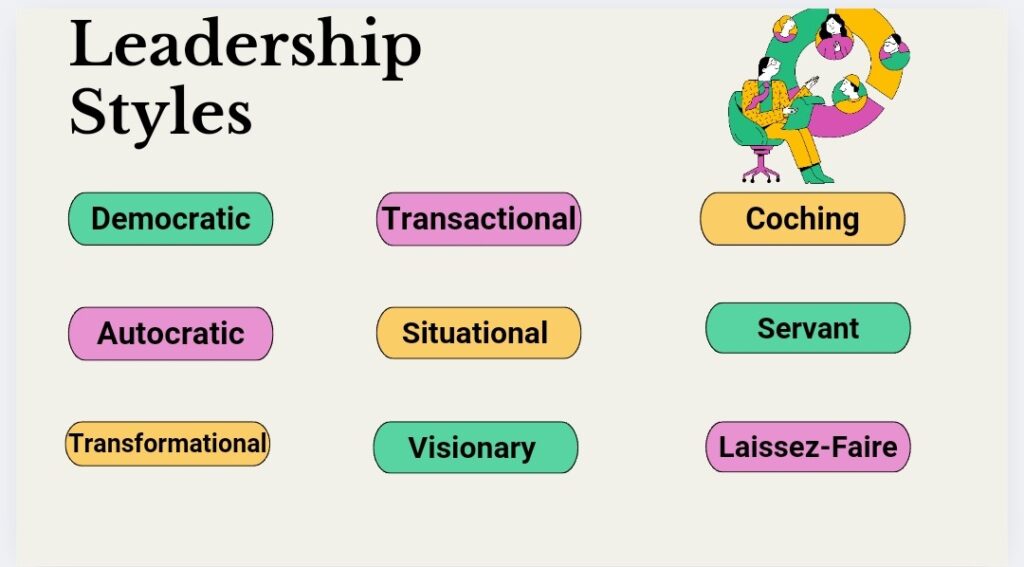Did you want to know important Leadership styles.Then first you need to know about leadership and fundamental qualities of leadership.

What is leadership?
Leadership is the ability of an individual or a group or individuals to affect and guide individuals who follow them or are part of an organization, society, or team.
We describe leadership as a social process that lets people work together to get things done that they couldn’t do alone, based on our decades of cutting-edge research and hands-on experience.
Leadership helps when people work together to get something done.
Fundamental Qualities Of Leadership
- The main goal of leadership is to help the group or organization reach its goals.
- Leaders create a cooperative atmosphere where people may collaborate well.
- Leaders motivate others to push forward for their compelling future vision.
- Communication is very important for sharing a vision, giving direction, and encouraging teamwork.
- Leaders make good choices that help the group or organization.
leadership styles
The behavioral strategy used by leaders to move, encourage, and guide their followers is referred to as their leadership style. A leader’s style defines how they carry out strategies and approaches to achieve certain goals while taking stakeholder expectations, team health, and soundness into care.
Now we are going to discuss 8 major leadership styles.

1.Democratic Leadership
Democratic leadership, often called participative or shared leadership, is a management style in which leaders actively involve their team members in decision-making.
This method promotes teamwork, open communication, and shared responsibility. Rather than a top-down, hierarchical structure, democratic leadership distributes power and authority throughout the company, promoting participation and feedback from all levels.
- In democratic leadership style,Information is freely exchanged, and team members are encouraged to voice their opinions and concerns.
- Leaders are honest about their judgments and the reasoning behind them, which promotes trust and understanding.
- Democratic leadership creates friendship and trust among team members.
2.Autocratic Leadership
Autocratic leadership, often known as authoritarian leadership, is a method of leadership in which a single leader possesses all decision-making authority and expects subordinates to blindly obey orders.
Autocratic leadership style can be identified by a top-down approach, with the leader making decisions primarily on their own judgment and rarely seeking feedback from others. While it can be useful in certain situations, such as during emergencies or in highly regulated organizations, if not implemented correctly, it can also lead to poor morale and productivity.
In Autocratic leadership,Leaders make all important decisions without communicating the team.
The main focus of autocratic leadership is on meeting goals and objectives, with little regard for staff well-being or happiness.
3.Transformational Leadership
Transformational leadership is a leadership style in which leaders inspire and motivate their followers to achieve a common goal by encouraging positive change and personal development. It involves inspiring people, stimulating creativity, and establishing a strong organizational culture.
This method focuses on motivating followers to go above their perceived talents and contribute to the organization’s success.
Leaders inspire and stimulate their people by communicating a compelling vision and demonstrating confidence in their talents.
4.Transactional Leadership
Transactional leadership is a management approach that highlights communication between leaders and followers, using rewards and penalties to drive success. This strategy places an intense focus on upholding order and achieving particular objectives via a system of conditional rewards and correctives.
In simple terms, it’s a “give and take” approach in which leaders establish clear goals, offer rewards for achieving them, and take appropriate action when necessary to address underperformance.
To keep things efficient and in order, transactional leadership depends on well-defined policies, processes, and authority structures.
Followers are more influenced by outside forces, such as promotions, than by an innate interest in the task at hand.
5.Situational Leadership
Situational leadership is a leadership style in which leaders change their approach based on the demands of their followers and the specific circumstances at hand.
It involves adjusting leadership styles according to the objectives, team members’ backgrounds, and the situation as a whole. The objective is to optimize effectiveness by matching the leadership style with the circumstances and the team’s or individual’s developmental stage.
The ability of leaders to switch between various leadership philosophies when necessary is brought out by situational leadership.
6.Visionary Leadership
Visionary leadership is a leadership style that focuses on developing and expressing a powerful plan for the future, inspiring and motivating others to attain ambitious objectives. It requires strategic thought, inventiveness, and the capacity to organize a team around a common goal, which typically results in considerable positive change inside an organization.
Visionary leaders establish ambitious objectives and motivate their people to achieve them by communicating a clear and compelling vision of the future.
7.Coaching Leadership
Coaching leaders help their team members grow both personally and professionally by giving them advice and support.
The goal of coaching leadership is to empower and develop staff members by helping them to enhance their abilities and output. In order to help team members realize their full potential, leaders who use this strategy take on the role of coaches, providing encouragement, support, and helpful feedback.
Coching leaders focuses on creating trust and encouraging self-improvement over simply assigning work.
8.Servant Leadership
Being a servant leader means putting the needs of the team before your own.
A servant-leader prioritizes the development and welfare of individuals and the communities they are part of. In contrast to traditional leadership, which typically involves the “top of the pyramid” gaining and using authority, servant leadership is different. In addition to sharing authority and emphasizing the needs of others, the servant-leader promotes the growth and performance of others.
Servant leadership is a style in which the leader’s objective is to serve.
9.Laissez-Faire Leadership
Laissez-faire leadership is a style in which leaders don’t get involved and give their subordinates a lot of freedom and ability to make decisions.
It can be identified by minimum involvement, which allows team members to manage their jobs and projects with great freedom. While it can promote innovation and independence, it also requires a highly competent and motivated staff to function effectively.
Employees are empowered to make their own judgments and take responsibility for their work.
Leaders provide broad direction without micromanaging or closely monitoring everyday tasks.
When staff are experienced, knowledgeable, and self-directed, this approach can be quite effective.